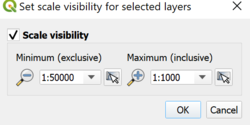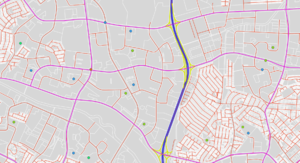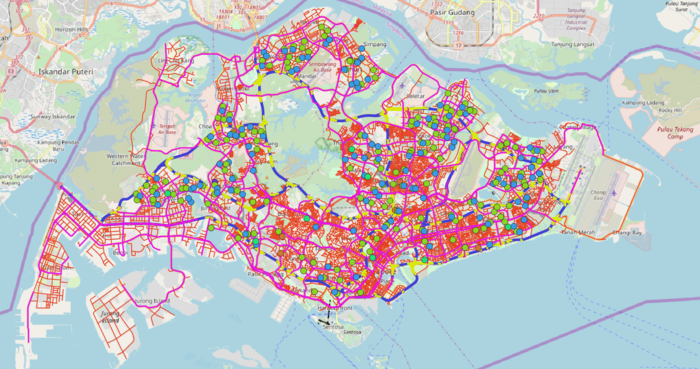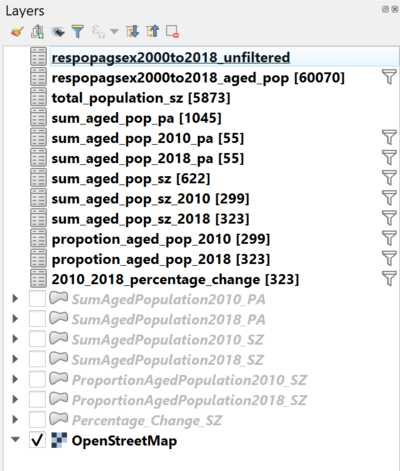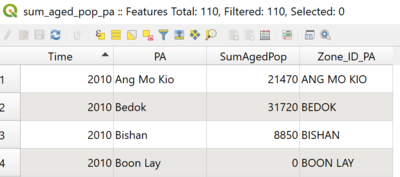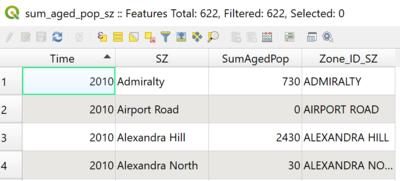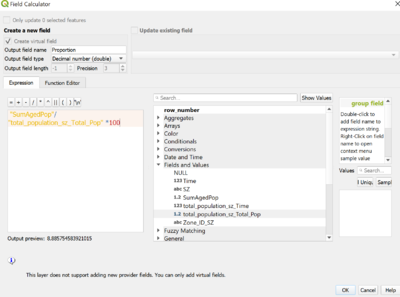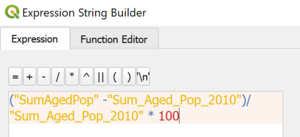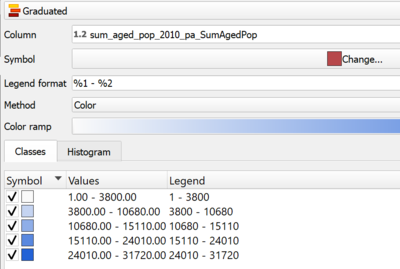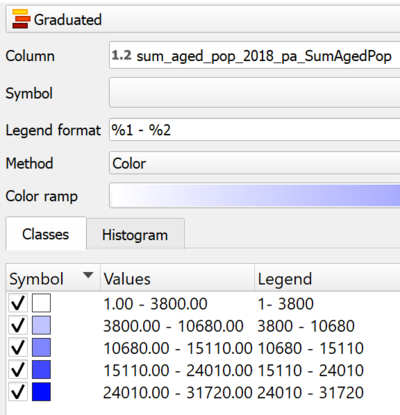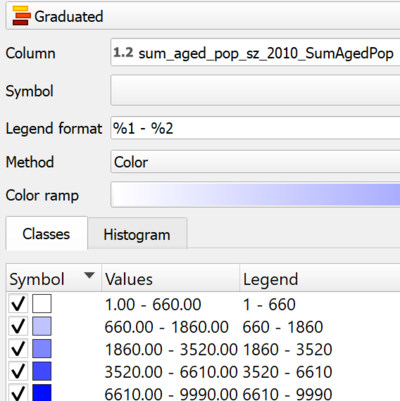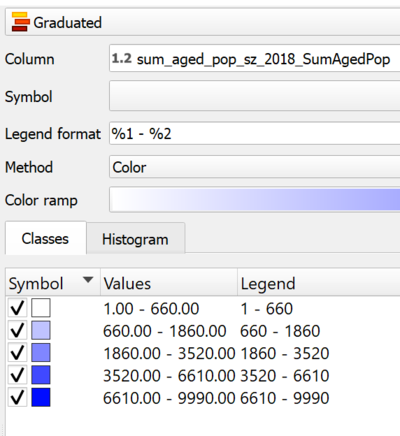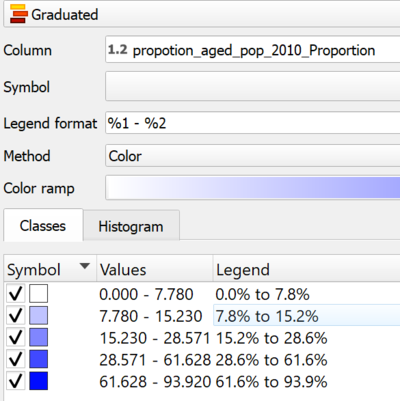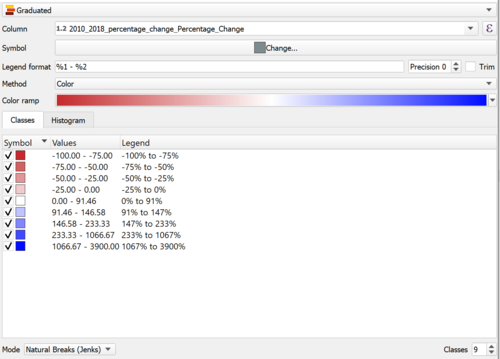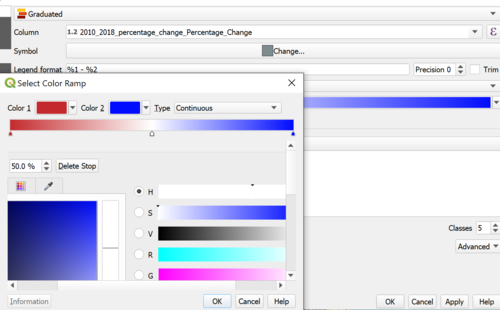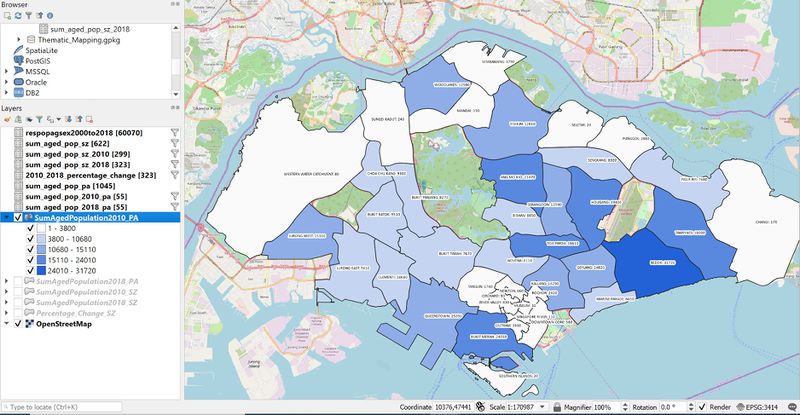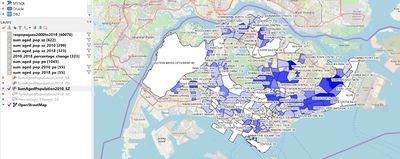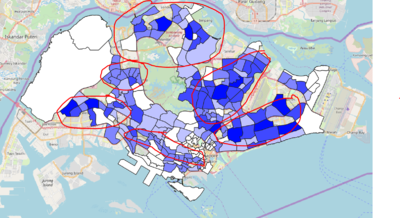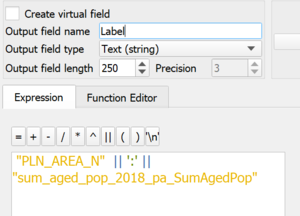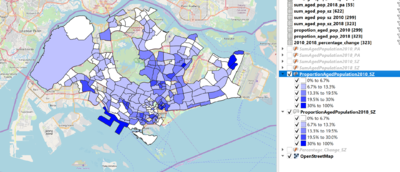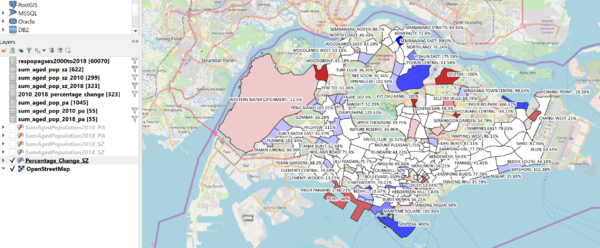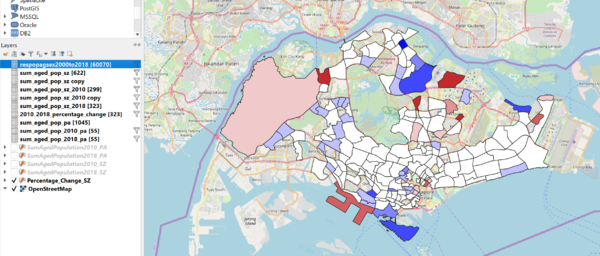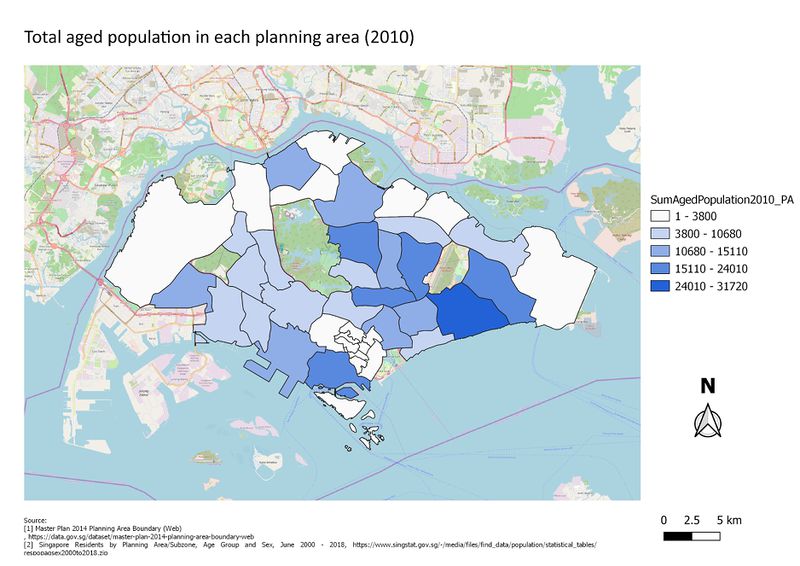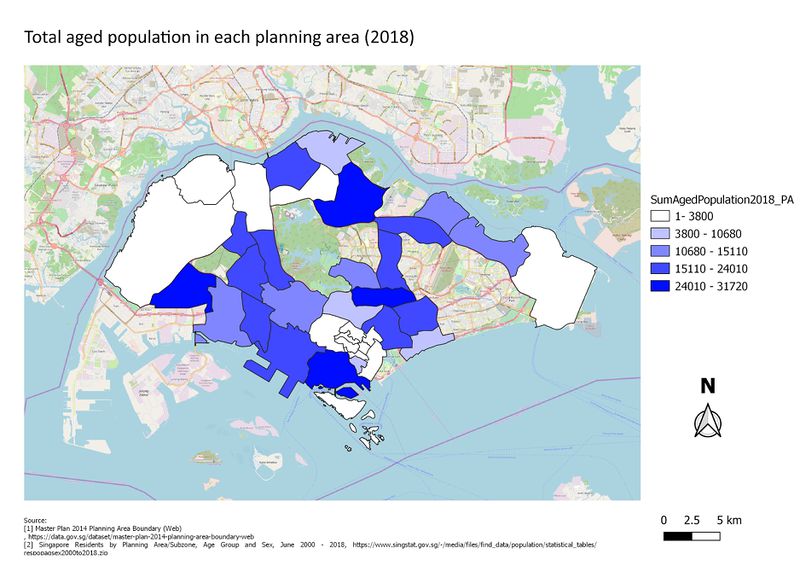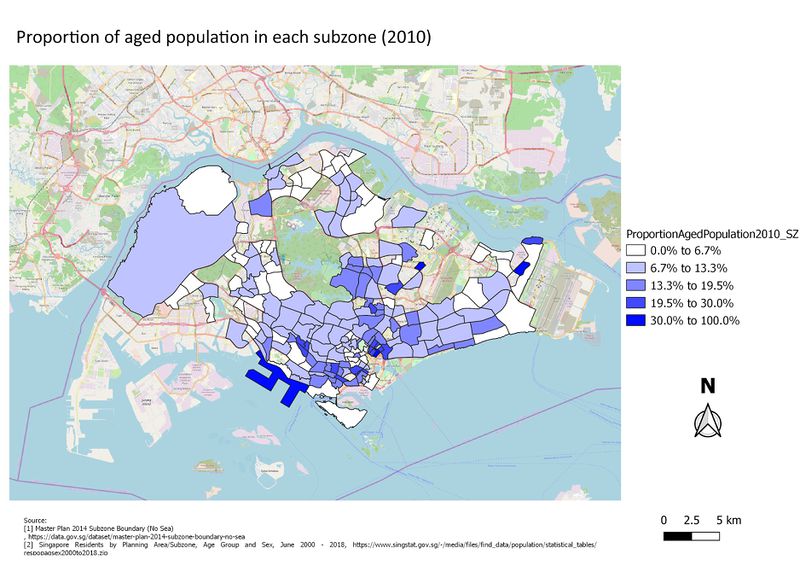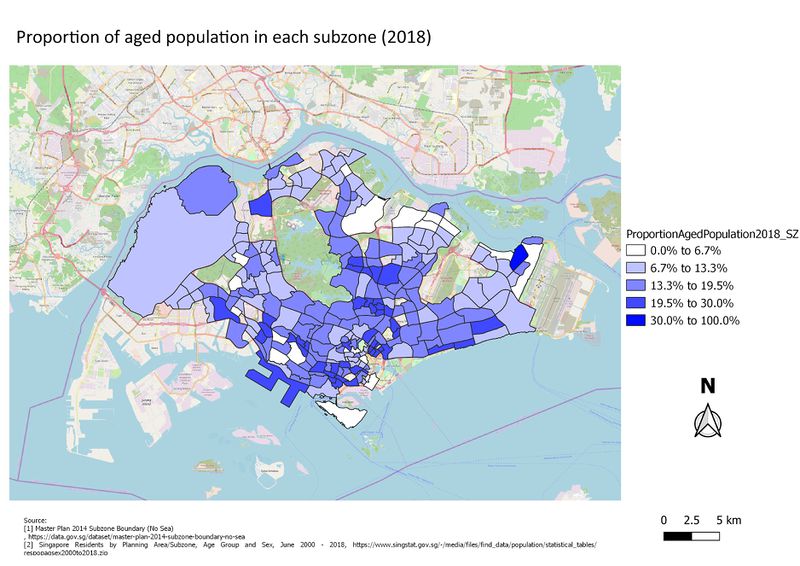SMT201 AY2019-20G2 Ex1 JerryTohvan
Part 1: Thematic Mapping
The thematic mapping developed uses these following data and applied techniques:
| Data | Visualisation & Processing Technique |
|---|---|
| General information of schools from the “School Directory and Information” dataset retrieved from data.gov.sg. | Layer: School
Symbology: Categorised by `mainlevel_` attribute which indicates if an indicated point belongs to either centralised institute, junior college, mixed level, secondary or primary school. Each category is labeled with following color: FIGURE I ROAD SELECTION LINE AND MAP LINE
Processing: The initial dataset was geocoded using the MMQIS by its `address` field in order to retrieve `latlong` projection of the data points. Data not found: |
| “Masterplan 2014 Landuse” dataset retrieved from data.gov.sg. | Layer: Land Use
Symbology: Light Grey simple fill
FIGURE II SCALE VISIBILITY
|
| SLA’s National Map Line retrieved from data.gov.sg. Road Selection Line dataset retrieved from SLA provided by Prof Kam (HandsOnEx1). |
Layer: Map Line & Road Network
FIGURE III ROAD SELECTION LINE AND MAP LINE Processing: 2 datasets was used to represent different types of road. The national map line only provides expressway, major roads, international boundary and contour lines, the road selection data provides overall road network in Singapore. The Map Line layer highlights its road types using the categorisation rule, applying different colours and line width to emphasize type of road. The minor road can be implied by excluding road network that belongs to express way, intersections, and major roads. |
| “MP14_SUBZONE_NO_SEA_PL” by URA retrieved from data.gov.sg. | Layer: MP14_SUBZONE_NO_SEA_PL
Symbology: Light Brown simple fill Was included to provide a macro view base layer as an optional display. The layer represents subzones that could be useful in interpreting where road networks or school is located. OpenStreetMap view could also be used, however the subzone layer better express the subzone boundaries through a simple display. |
FIGURE IV
OVERVIEW OF THEMATIC MAPPING
Firstly, the thematic mapping shown in figure 5 represents the default view of the map. School data points, map line and road network are shown on top of the OpenStreetMap.
FIGURE IV
MICRO VIEW OF LAND USE VISIBILITY WITH ROAD NETWORKS AND SCHOOL DATA POINTS
The land use data was set with automatic scale visibility, the overall land use layer will only be clearly visible as the user zooms in for interpretation. The land use data provides a micro level data of the indicative polygon of each development land parcel. Thus, there’s no need for this layer to be displayed in a more macro view as lines will not be value-adding to visualisation interpretation.
Next, the national map line only provides expressway (blue line), major roads (magenta line), international boundary and contour lines (excluded), while the road selection data provides overall road network in Singapore. Thus, achieving an overview of all types of road can be done by overlapping the road networks to retrieve minor road (red line) through overlapping as shown in figure V.
FIGURE VI
SUBZONE VIEW
FIGURE VII
OPENSTREETMAP VIEW
The `MP14_SUBZONE_NO_SEA_PL` and OpenStreetMap layer (Figure VI & VII) were added as I believe that it might help in terms of data interpretation, eg: finding out where a junior college is located by subzones and its distance to major road where it's usually major road provides better transportation option/accessibility.
Part 2: Choropleth Mapping
FIGURE VIII
LAYERS EXPORTED
The choropleth mapping developed uses these following data and applied techniques:
Sources and Methods
| Dataset | Visualisation & Processing Technique |
|---|---|
| “Singapore Residents by Planning Area/Subzone, Age Group and Sex, June 2000 - 2018” from Department of Statistics Singapore. |
Layer: respopagsex2000to2018_unfiltered Processing: 1. The initial dataset is the base population data yet to be processed with the map layer data. FIGURE IX FILTERING AGED POPULATION 2. Layer`respopagsex2000to2018_aged_pop` was achieved by filtering attribute `AG` which represents the age groups.
FIGURE X AGGREGATING DATA USING GROUPSTATS
FIGURE XI IMPORTING GROUPSTATS GENERATED CSV USING CUSTOM DELIMITER 3. Plugin `Group Stats` was used to group by data with a simply drop-and-drag feature. In which could perform operations such as general table operations with group by, selection of columns, and data aggregation. The plugin helps to produce these following files and layers: a. `sum_aged_pop_pa` and `sum_aged_pop_sz` from file `/GroupStats/sum_aged_pop.csv` and `/GroupStats/sum_aged_pop_sz.csv` respectively which was achieved by a sum aggregation of aged population grouped by year and subzones/planning areas. b. Layer `total_population_sv` from file `GroupStats/total_population_sz.csv` was a product of a sum aggregation of all population grouped by year and subzones. FIGURE XII DATA OVERVIEW OF IMPORTED GROUPSTATS DATA
FIGURE XIII DATA OVERVIEW OF IMPORTED GROUPSTATS DATA 4. Layer `sum_aged_pop_pa` and `sum_aged_pop_sz` were used as a base data for getting the aged population (+65) in 2010 and 2018 data on each subzones and planning area filtered using the `Time` attribute. a. Thus, producing layer `sum_aged_pop_2010_pa`, `sum_aged_pop_2018_pa`,`sum_aged_pop_2010_sz` and `sum_aged_pop_2018_sz`. b. `Zone_ID_SZ` and `Zone_ID_PA` were an additional attribute for primary keys needed to join with the subzone and planning area data. We applied expression `upper(“SZ”)` and `upper(“PA”) for an uppercase reference of the attribute included. 5. We derive the layer `propotion_aged_pop_2010` and `propotion_aged_pop_2018` by layer joining of `total_population_sz` and `sum_aged_pop_sz` through`SZ` attribute as keys and applying `Time` filter for respective layers. FIGURE XIV PROPORTION FIELD CREATION
a. Using the `Field Calculator`, we add new attribute `Proportion` by dividing subzone aged population by its subzone total population. FIGURE XV DERIVING PERCENTAGE CHANGE 6. Lastly, the `2010_2018_percentage_change` layer was achieved simply by layer joining from `sum_aged_pop_sz_2010` and `sum_aged_pop_sz_2018`. Data clean up was done to replace any `NULL` values to 0. Above figure represents the expression formula used to derive the percentage change from 2010 to 2018.
|
| Singapore Master Plan 2014 Subzone and Planning Area 2014 boundary data retrieved from data.gov |
1. `SumAgedPopulation2010_PA` layer joined with `sum_aged_pop_2010_pa` by matching attribute `PLN_AREA_N` and `Zone_ID_PA`. a. Symbology (Natural Jenks): FIGURE XVI CATEGORISATION OF PLANNING AREA SUM AGED POPULATION DATA
FIGURE XVII CATEGORISATION OF PLANNING AREA SUM AGED POPULATION DATA
FIGURE XVIII CATEGORISATION OF SUBZONE SUM AGED POPULATION DATA 4. `SumAgedPopulation2018_SZ`layer joined with `sum_aged_pop_2018_sz` by matching attribute `SUBZONE_N` and `Zone_ID_SZ`. a. Symbology (Natural Jenks): FIGURE XIX CATEGORISATION OF SUBZONE SUM AGED POPULATION DATA 5. `ProportionAgedPopulation2010_SZ` layer joined with `propotion_aged_pop_2010` by matching attribute `SUBZONE_N` and `Zone_ID_SZ`. a. Symbology (Natural Jenks):
FIGURE XX CATEGORISATION OF SUBZONE PROPORTION AGED POP DATA 6. `ProportionAgedPopulation2018_SZ` layer joined with `propotion_aged_pop_2018` by matching attribute `SUBZONE_N` and `Zone_ID_SZ`. a. Symbology (Natural Jenks): FIGURE XXI CATEGORISATION OF SUBZONE PROPORTION AGED POP DATA 7. `Percentage_Change_SZ` layer joined with `2010_2018_percentage_change` by matching attribute `SUBZONE_N` and `Zone_ID_SZ`. a. Symbology: Below is the configuration used for percentage change of aged population. The legend classification intervals were split into 2 ways, negative changes which represents a decrease change were categorised using an equal distribution from the minimum decrease value of -100% to 0. Next, Natural Breaks (Jenks) were used to classify the 5 next categories for the positive values to indicate. Due to its high variance value, the Jenks classification represents best for this case. Additionally, 2 distinct colours (red and blue) were used to appropriately display the nature of percentage change of the aged population from 2010 to 2018. FIGURE XXII CATEGORISATION OF SUBZONE PERCENTAGE CHANGE DATA FIGURE XXIII 3 BASE COLOR PICK FOR SUBZONE PERCENTAGE CHANGE DATA
FIGURE XXIV DATA LABELLING For each respective boundary map object, we created `Label` attribute for data visualisation in which was disabled for better macro level view and observation.
FIGURE XXV CATEGORISATION OF SUBZONE PERCENTAGE CHANGE DATA
|
Data Interpretation
Aged population (+65) in 2010 and 2018
FIGURE XXVI
OVERVIEW MAP OF TOTAL AGED POPULATION IN 2010 BY PLANNING AREA
The plotted map above represents the total aged population (+65) in 2010 by each planning area at the macro level. We observe that there is a tendency that more of the aged population tend to reside in the east area, especially Bedok with an approximate figure of 31,720. Next, areas like Tampines, Hougang, Toa Payoh, Ang Mo Kio, and Bukit Merah were already recorded as areas with many older generations residing in 2010. The data classification excludes 0 as we are not interested in areas with unrecorded data as it doesn’t bring a value.
FIGURE XXVII
OVERVIEW MAP OF TOTAL AGED POPULATION IN 2018 BY PLANNING AREA
As we all already know that Singapore is one of the countries that is currently facing an aging population as a nation. In Figure XXVII, we can observe that the problem is currently displayed on the macro view of total aged population in 2018 map. We see areas like Woodlands which had a major increase of aged population from 12,580 to 22,040 in the span of 8 years and more such as: - Yishun, 12,810 in 2010 and 24,720 in 2018. - Punggol, 2,880 in 2010 and 10,930 in 2018. - Sengkang, 8,920 in 2010 and 20,400 in 2018. - Serangoon, 12,590 in 2010 and 20,150 in 2018. - Sembawang, 3,790 in 2010 and 7,230 in 2018. - Bishan, 8,850 in 2010 and 14,430 in 2018. - Toa Payoh, 18,610 in 2010 and 24,030 in 2018. - Novena, 6,110 in 2010 and 8,130 in 2018. - Kallang, 14,290 in 2010 and 19,890 in 2018. - Bukit Merah, 24,010 in 2010 and 31,490 in 2018. - Queenstown, 19,400 in 2010 and 19,400 in 2018. - Bukit Panjang, 8,270 in 2010 and 15,210 in 2018. While the above-mentioned planning areas have shown a significant increase there are locations that have been stagnant perhaps due to no recent surveys conducted yet and some areas experiencing decrease of aged population.
FIGURE XXVIII
OVERVIEW MAP OF TOTAL AGED POPULATION IN 2010 BY SUBZONE WITH LABEL
Figure XXVIII shows the total aged population of each subzone to provide a more detailed view in each subzone. Label attribute has been allocated to represent each subzone and easy reference which for the next map screenshots has been disabled for better classification analysis.
FIGURE XXIX
OVERVIEW MAP OF TOTAL AGED POPULATION IN 2010 BY SUBZONE WITHOUT LABEL
FIGURE XXX
OVERVIEW MAP OF TOTAL AGED POPULATION IN 2018 BY SUBZONE WITHOUT LABEL THAT SHOWS INCREASE AGED POPULATION
Figure XXIX shows the total aged population of each subzone to provide a more detailed view in each subzone. Label attribute has been allocated to represent each subzone and easy reference which for the next map screenshots has been disabled for better classification analysis. The red indicated areas predominantly shown significant additional number of aged population.
FIGURE XXXI
LABELLING FOR TOTAL AGED POPULATION BY PLANNING AREA/SUBZONE
Figure XXXI shows `Label` attribute created for both the aged population distribution by planning area and subzone for each of the map.
Proportional of aged population in 2010 and 2018
FIGURE XXXII
OVERVIEW MAP OF THE AGED POPULATION PROPORTION IN 2010 BY SUBZONE
FIGURE XXXIII
OVERVIEW MAP OF THE AGED POPULATION PROPORTION IN 2018 BY SUBZONE
We have seen the increase number of population total number for each planning area and subzone. However, we can’t seem to base the conclusion purely based on the increased number of aged population as we have to consider the proportion of non aged population to conclude that the proportion of the aged population is indeed increasing as to the overall population. We measure the proportion of the aged population with the following formulas:
● Total of aged population in 2010/total population in 2010.
● Total of aged population in 2018/total population in 2018.
Contrasting FIGURE XXXII and FIGURE XXXIIII we can see that in fact there is a trend of a spreading aged population especially in areas which used to be classified under 0% to 13.3% in 2010. In 2010, as we see that the increased proportion of the aged population has gone up to predominantly 6.7% to 19.5% with a spread across the subzones.
Percentage change of aged population between 2010 and 2018
Percentage Change only include those that has non 0 value in year 2010. Thus if 2018 have value it still doesn’t count as the percentage change is not valid,
FIGURE XXXIV
OVERVIEW MAP OFPERCENTAGE CHANGE BETWEEN 2010 & 2018 BY SUBZONE WITH LABEL
Figure XXXIV, shows the labeled region for the percentage of change between 2010 to 2018.
FIGURE XXXV
OVERVIEW MAP OFPERCENTAGE CHANGE BETWEEN 2010 & 2018 BY SUBZONE WITHOUT LABEL
To conclude the observation from the visualisation given, we apply percentage change of the aged population between 2010 and 2018. We are interested in knowing whether a particular region is experiencing a drop in the number of aged population or an increase. If there are either case we can to know the amount of increase and decrease. Firstly, we derive the percentage change shown in FIGURE XV. By applying negative and positive classification, we can conclude the extend of its aged population changed. While some areas are experiencing major increase of aged population like Alexandra Hill, Lower Seletar, Sembawang East and Pasir Ris Park, there are also areas that hand a major decrease of aged population like Pasir Panjang, Yio Chu Kang, Hougang Central, Seletar, Seletar Hills, Changi West, Changi Point, and Bugis. Interestingly, most subzones are in fact experiencing an increase of percentage change up to 6.7% indicated by the white subzones. Lastly, to end off it is crucial that the government will take into account the distribution of the aged population and redevelopment of programmes for the older generations. I believe that creating a tight-knit community also comes with being intentional in doing activities together, especially with those who are in the same generation. Next, with the current increasing rate of aging population which can be classified as pretty high, government can boost more initiatives in ensuring that we have enough next generations of leaders and citizens to carry on the Singapore successes in its development and economy as a nation.
Exported Maps from Map Composer
References
[1] https://data.gov.sg/dataset/school-directory-and-information
[2] https://data.gov.sg/dataset/master-plan-2014-land-use?resource_id=ea9f3b26-991f-48ea-ab58-e6b6d5fbaade
[3] https://data.gov.sg/dataset/national-map-line
[4] https://www.singstat.gov.sg/find-data/search-by-theme/population/geographic-distribution/latest-data
[5] https://plugins.qgis.org/plugins/GroupStats/
[6] https://data.gov.sg/dataset/master-plan-2014-subzone-boundary-no-sea

